When I think of French pastries, the first thing that pops into my mind is croissants, but did you actually know that croissants weren’t invented in France? Croissants as we know them today, can be found from the 1840’s in Vienna, but of course they’ve evolved a bit, with every pastry chef determined to offer the perfect croissant.
But what is the perfect croissant? The perfect croissant should consist of a leavened dough which is laminated with butter, so the end result is a light and buttery pastry with a flaky crust.
The trick is, they are incredibly finicky.
- You can’t knead the croissant dough too much.
- The dough and the butter need to be the same temperature and same texture prior to lamination.
- You have to be careful during the lamination process and not to crush the butter layers.
- Avoid manipulating the dough too much, don’t want the butter to melt
- Don’t over proof the dough
- Don’t under proof the dough
- Etc, etc
Is it even worth it, you may ask? Once you manage to make the perfect batch of croissants, all of those failed attempts fade away. The pride and satisfaction of taking that first bite is so worth it.
In preparations for my CAP, pate levée feuilletée or the dough that is used for croissants, pain au chocolats, pain au raisins etc, been my bête-noire or my main difficulty. Time and time again, I was just not getting those flaky layers I was looking for.
Now there are various recipes for croissants, most of them are quite similar. My favorite recipe thus far has actually been the Le Cordon Bleu recipe. I have personally gotten the most constant results with this recipe.
Making the dough
Much like the Chaussons aux pomme recipe, the first step would be what we call the détrempe. In a bowl of a mixer, crumble the fresh yeast over the liquid (water & milk). Cover the liquid with the flour and then put the sugar and salt on opposite sides of the bowl with the softened butter in the middle. After pulling this together into a dough, double wrap it in plastic wrap and let it proof in the fridge for 24 hours.
Before pulling the dough out of the fridge prepare the butter. On a large piece of parchment paper, place the butter and start to beat it with your rolling pin, folding it over on itself once it gets too thin and then start again. Continue until the butter is soft and pliable. You’re aiming for it to be the same texture as the détrempe. Fold the parchment paper over the now softened butter, creating a square and locking the butter in. With the rolling pin, roll the butter into all corners of the square, making sure it’s all even, then put it in the fridge for about 10 minutes.
Lamination Process
The détrempe needs to be rolled out to three times the length of the butter square. Place the butter in the middle, then fold the dough over the butter, enveloping it dough. With the rolling pin, press down on the open ends, to seal the the butter in.

Roll the dough out to about 50cm in length and brush off the excess flour. If you find it resisting and shrinking when you’re rolling it out, that means it’s not cold enough. Wrap it in plastic wrap and let it chill a bit longer. Then proceed with a single fold as pictured below.
Rotate the dough, so the ends are on the top and bottom and the seam is to your right. Roll the dough out to about 50cm in length and brush off the excess flour. Fold both ends into the middle until they meet, brush off excess flour again, then fold in half. This completes your first double fold.
Let the dough rest in the fridge for at least 30 minutes before proceeding with another simple fold and another double fold. In total, you should have 2 simple folds and 2 double folds. When you’re first familiarizing yourself with the process, I would suggest putting the dough in the fridge for around 15 minutes between each fold. This will keep the butter from getting too soft and melting into the dough while you’re working with it.
How to roll croissants
Roll out the croissant dough to a rectangle of 28×34. It is crucial to work slowly and gently, so you don’t crush the layers of butter that you worked so hard to create. This is easier with cold dough, so if you find the dough shrinking as you roll it out, just pop it in the fridge for 10 minutes and then continue.
Once you get your dough to the right size, use a large chef knife and in one cut, trim off the edges. You’re dough should be about 26×32 at this point. Cut out 8 triangles, with a base of 8cm and height of 26cm.
When you have your triangles cut out, make a slit in each triangle on the bottom. This will allow you to pull the ends of the triangle to elongate what will become the “ears”. Gently roll up the croissants. Pull slightly on the “tail” of the triangle before finishing your roll. Place the croissants on a baking sheet covered with parchment paper, setting it down so that the “tail” is on the bottom.

Pains aux chocolats
If you’re in the mood for pains aux chocolats instead of croissants, cut the dough as shown in the diagram below. You’ll have some excess dough but a lot less than when making croissants. In this case, place a chocolate bar at the top of each rectangle, then fold the dough over the chocolate. Add a second chocolate bar, then continue rolling up the dough.

Place them on the baking sheet, with the end touching the pan. Make sure there is ample distance between them, so they don’t touch after raising. Baking time is the same as croissants.

Egg Wash
There are a couple different egg washes that you can do. You can mess around with them and figure out what one you like the best in the end.
- Famous french pastry chef Cédric Grolet uses equal parts of egg yolk and heavy cream as an egg wash, swearing that the extra fat in the cream contribute to his award winning pastries
- Other egg washes use whole eggs mixed with a bit of liquid, either water or milk
- Personally, I use egg yolk mixed with a splash of milk, small pinch of salt and big pinch of sugar.
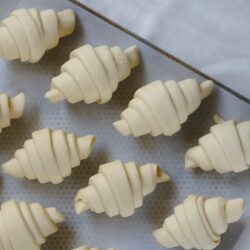
Flaky French Croissants
Ingredients
- 250 g Flour, T45
- 250 g Flour, T55
- 10 g Salt
- 20 g Fresh Yeast
- 60 g Granulated Sugar
- 50 g Butter
- 160 ml Water
- 160 ml Milk
- 225 g Dry Butter, 84% Fat
Instructions
Croissant Dough
- Dissolve the yeast in the liquid in the mixer bowl. Add flour, covering the liquid entirely.
- Add the sugar and salt to opposite sides of the bowl, with the butter in the middle and mix with the dough hook on slow.
- Once the dough starts to come together, bring the speed up to medium.
- Let mix for 10 minutes or until the dough becomes elastic.
- Loosly double wrap in plastic wrap and let rest in the fridge for 24 hours.
Lamination
- After the dough has rested, prepare your dry butter.
- Place the butter on one side a sheet of parchment paper. Using a rolling pin, beat the butter until it is soften, folding it over on itself three or four times when it starts to get too thin and start again. Your goal is to have the butter to be the same consistency as the dough.
- Once the butter is the correct consistency, fold the parchment paper over the butter and fold in the sides, creating a closed square. Roll the butter into a flat sheet and be sure to roll into the corners.
- Put the butter in the fridge for 10 minutes
- Take your dough out of the fridge and start to roll out into a long rectangle, large enough to fit the square of butter to fit in the middle and enough excess to on the top and bottom to fold over the butter.
- Once the butter is cold again (it should be the same temperature as the dough, this is when a laser thermometer comes in handy), turn out into the middle of the rectangle. Fold the sides of the dough, joining the ends together in the center, enveloping the butter in dough. Use the rolling pin to close the ends of the dough, sealing the dough inside.
- Flour the surface of the dough and ensure that there is enough flour underneath as well, so your dough will not stick. If it sticks, the dough will rip and your precious butter will leak out.
- With the rolling pin, make an X by pressing down on the dough and to keep the butter from sliding around. Start rolling out the dough in length (the length of your rolling pin +10cm).
- Remove the excess flour, divide into 3rds, folding the first 3rd, and then remaining end in half. Fold once again in half.
- Wrap and let chill in the fridge for 30 minutes
- Dust the chilled dough with flour and create a X with your rolling pin, before rolling out in the opposite direction as you previously did.
- Lightly roll width wise, then work on the length, the size of your rolling pin + 15-20cm. Try to keep the same thickness throughout.
- Fold in fourths, then in half. Cover and let rest in the fridge for 30 minutes
- Roll out into a rectangle that is about 28cm x 34cm. Trim all of the edges, so you have straight lines.
- The dough will shrink slightly, but that is fine. Your triangles should have a height of 26cm
- Measure out aver 8cm on the long side and leave notches on the dough.On the parallel side, count 4cm, then notch every 8cm. These act as your cutting guidelines. Cut out your triangles and dispose of left over dough.
- Pull on the two smaller corners of the triangle to form the ears.
- Roll up the croissants and place on a parchment lined baking trays. Brush with an egg wash and cover to let proof for about 2 hours
- Preheat the oven for 165°C (320°F)
- Once the croissants are done proofing, brush with egg wash a second time and then cook for 18 minutes
Nutrition
Croissant Trouble-Shooting
- What is dry butter?
- Dry butter may be difficult to find outside of France. The fat content is 84% and has a higher melting point, making it ideal for puff pastry.
- Alternative options would be any imported French butters, brands such as President, Beurre d’Isigny…these are generally 82% fat.
- My dough is hard to roll out and keeps shrinking when I roll it out. What am I doing wrong?
- The dough is too warm, put it back in the fridge and let it cool for 15-20 minutes before continuing. Don’t put too much force into rolling out the door, you’ll crush the layers of butter you worked so hard to create.
- Can I freeze my croissants?
- Yes, you can! I suggest freezing them after they’re rolled but before you proof them the final time.
- How do I know if the dough is proofed and ready for baking?
- The dough is ready when you lightly shake the baking sheet and the croissants wiggle slightly like jello.
- You should also see layers of dough if you look at the croissants from the side








Very helpful recipes
Thanks
Thank you very much!